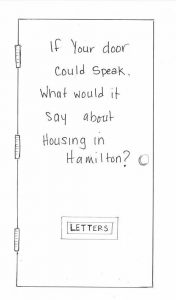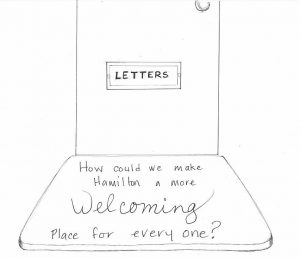Expanding community networks part two: Hamilton Public Library
“This performance needs to be done more — in the schools, in the colleges, in the universities — to raise awareness about the rights of the tenants.”
— Performer-advocate, When My Home is Your Business.
While we were busy hatching plans with our Good Shepherd community partners, we were also planning a re-performance of When My Home is Your Business with partners from the Social Planning & Research Council of Hamilton (SPRC). The play’s previous performances had taken place as part of larger events organized around issues related to displacement, tenant rights, affordable housing, and homelessness. A huge advantage of these kinds of venues is that they have built-in audiences of stakeholders who are invested in the issues that the play addresses. But with no similar events on the horizon, we set out to explore new options.
At the time, we had also been thinking about ways to integrate TSDC into the broader community and (as we discussed above) had just started talking with Naomi Brun and Erica Conly at the Hamilton Public Library about collaborating with TSDC and Notre Dame House School on Choose Your Destination2. So, we discussed the idea of the library as a venue for When My Home is Your Business and decided that it was excellent choice for a number of reasons:
- Many of the play’s performer-advocates had expressed a desire for the play to reach broader audiences.
- Unlike conferences, which are temporary spaces, libraries are permanent and designed as sites for public engagement and exchange.
- Libraries (especially City Centre libraries) are fantastically public spaces that host a diverse range of communities.
When we began imagining the kinds of pre- and post-performance activities that might be possible at the library, we became almost giddy with excitement! We had long worked with post-performance activities to offer audience members creative ways to extend their engagement beyond the performance. With the library, it struck us that the kinds of activities we could consider were no longer limited to those we could initiate immediately after the performance. Activities to support the play and the community engagements it sought to foster could extend over a much longer timeframe, taking place before, as well as after, the performance. Our imaginations ran with the possibilities. (We’re talking processions of people through the library wearing sandwich board signs painted with the question, “What does home mean to you?” ) Because of time constraints, we reined ourselves in to land on two projects:
Zine-making workshop with tenant rights advocates:
We were extremely lucky to have Merima Menzildzic on our performance planning team. In her role as project coordinator of the Social Planning and Research Council of Hamilton’s Tools For Tenant Rights project, Merima facilitated workshops and training sessions for tenants facing displacement due to gentrification. Since the themes of the play intersected with the issues addressed by Tools For Tenant Rights we began talking about creative ways that the two projects could support one another.
Here’s what we came up with: Merima and Melanie (TSDC’s set and prop designer) would work together to offer a couple of zine-making workshops to tenants at risk of being displaced and tenant rights advocates. The idea was to create single page zines that could be cut and folded into an eight-page storyboard. The zines could include both promotional information for the play and information addressing tenants concerns and tenant rights. They could be made available at the library before, during, and after the performance. The zines would also be available to the zine-making participants to share in their own communities and as part of their tenant rights advocacy activities.
Interactive community art installation:
As we met in the food court near the main entrance to Hamilton Public Library’s Central Branch to brainstorm pre- and post-performance activities, we had an Aha! moment. A queer youth advocacy group was hosting an interactive art exhibit at the entrance. It was visible to us in the food court and anyone who used this entrance to the library passed by it. We decided to follow their lead and plan an interactive exhibit that would promote and support the play by fostering public discussion and engagement around housing related issues.
 Here’s what we had come up with: Melanie would create a door — like the doors from the set of When My Home is Your Business, with a one exception. The door would have a mail slot. We would have two sets of postcards available for people to fill out and drop through the slot. One would have an image of a door on the front with the question, If your door could speak, what would it say about housing in Hamilton? The second would have a drawing of door mat, with the question, How could we make Hamilton a more welcoming place for everyone? Postcards would be gathered and put on display in the library.
Here’s what we had come up with: Melanie would create a door — like the doors from the set of When My Home is Your Business, with a one exception. The door would have a mail slot. We would have two sets of postcards available for people to fill out and drop through the slot. One would have an image of a door on the front with the question, If your door could speak, what would it say about housing in Hamilton? The second would have a drawing of door mat, with the question, How could we make Hamilton a more welcoming place for everyone? Postcards would be gathered and put on display in the library.

Plans for the zine workshops and installation were still works-in-progress when we had to postpone the performance (insert COVID refrain). Though we were unable to bring our plans into fruition, what became abundantly clear to all of us was what an incredibly valuable partner libraries could be to projects like TSDC!
As public institutions that serve a broad range of communities, libraries open up an exciting range of new possibilities that include:
- Inviting a broader public into the conversations plays foster by presenting them in a public forum that engages a broad spectrum of communities.
- Creating interactive art installations to accompany plays as a way of cultivating ongoing public discussion and engagement around themes of the play.
- Leveraging library resources and regular library activities to help spur a deeper conversation around some of the themes that emerge from the production.
- Expanding infrastructural networks and developing reciprocal relationships.
- Mobilizing library resources (like ‘maker spaces’) for community members to create zines or digital stories related to the plays’ themes.

